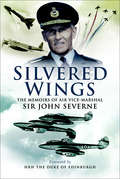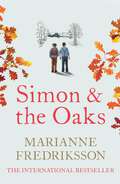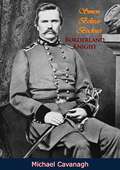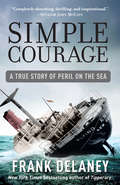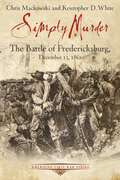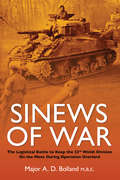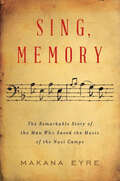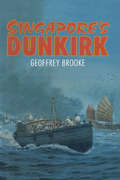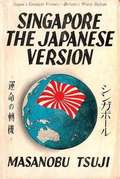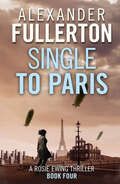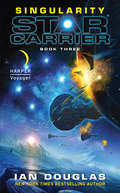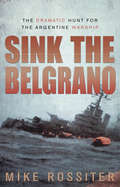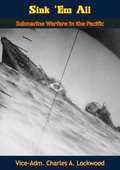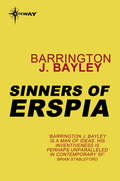- Table View
- List View
Silvered Wings: The Memoirs of Air Vice-Marshal Sir John Severne
by John SeverneJohn Severne joined the RAF in 1944 and gained his wings two months after World War II ended. This book captures the authors great passion for flying, whether it be in jet-fighters, light aircraft, helicopters or making model planes and gives details of his long a illustrious career.His first posting was to No 264 Night Fighter Squadron flying the de Havilland Mosquito. On a flying instructors course at the Central Flying School, he flew a Lancaster, Spitfire and his first jet the Vampire. Posted to Germany as a flight commander on a Venom squadron, he was awarded an Air Force Cross for landing an aircraft that had caught fire. As a Squadron Leader, he became Equerry to the Duke of Edinburgh. Then followed a period as chief instructor on Britains first supersonic fighter, the English Electric Lightning. Later he became Wing Commander Ops at the joint HQ of Middle East Command where he was involved in counter-terrorist operations in Aden. As Station Commander of RAF Kinloss, he was responsible for the introduction of the Nimrod in 1971 and at the height of the Cold War when these new anti-submarine aircraft were a vital part of Britains defense.
Simon And The Oaks
by Marianne Fredriksson'Sad and funny, this is a wonderful book. I didn't want it to end' WOMAN'S WEEKLY'An enthralling saga, set in Sweden, about the lives of two boys before, during and after the war ... impossible to put down' THE TIMESAs a child, Simon was always aware that there was something different about him, something that caused late-night quarrels and sometimes tears. With the rise of Hitler in Germany and the coming of war to Sweden's neighbours, the tensions increase.Befriending a young Jewish boy, Isak, who is quickly taken under his mother's wing, enriches Simon's life, but makes it more difficult too - for Isak seems to fit in much better at home than Simon does.With the war's end comes the day when Simon must be told the truth. The truth about his affinity for the lake and its surrounding oak trees; for the strange dreams of an old man beneath the ways - and the truth about his past.
Simon And The Oaks
by Marianne Fredriksson'Sad and funny, this is a wonderful book. I didn't want it to end' WOMAN'S WEEKLY'An enthralling saga, set in Sweden, about the lives of two boys before, during and after the war ... impossible to put down' THE TIMESAs a child, Simon was always aware that there was something different about him, something that caused late-night quarrels and sometimes tears. With the rise of Hitler in Germany and the coming of war to Sweden's neighbours, the tensions increase.Befriending a young Jewish boy, Isak, who is quickly taken under his mother's wing, enriches Simon's life, but makes it more difficult too - for Isak seems to fit in much better at home than Simon does.With the war's end comes the day when Simon must be told the truth. The truth about his affinity for the lake and its surrounding oak trees; for the strange dreams of an old man beneath the ways - and the truth about his past.
Simon Bolivar Buckner: Borderland Knight
by Arndt SticklesTrained at West Point, Buckner saw service in the Mexican War but retired to private life afterwards. With the outbreak of the Civil War, he became a general in the Confederate army. In the troublesome years following the war, he served as governor of Kentucky. Cultured, courtly, unostentatious, Buckner was the Borderland Knight, truly great in his simplicity.-Print ed.
Simple Courage: A True Story of Peril on the Sea
by Frank Delaney“HEAVEN HELP THE SAILOR ON A NIGHT LIKE THIS.”–old folk prayerIn late December 1951, laden with passengers and nearly forty metric tons of cargo, the freighter S.S. Flying Enterprise steamed westward from Europe toward America. A few days into the voyage, she hit the eye of a ferocious storm. Force 12 winds tossed men about like playthings and turned drops of freezing Atlantic foam into icy missiles. When, in the space of twenty-eight hours, the ship was slammed by two rogue waves–solid walls of water more than sixty feet high–the impacts cracked the decks and hull almost down to the waterline, threw the vessel over on her side, and thrust all on board into terror.Flying Enterprise’s captain, Kurt Carlsen, a seaman of rare ability and valor, mustered all hands to patch the cracks and then try to right the ship. When these efforts came to naught, he helped transfer, across waves forty feet high, the passengers and the entire crew to lifeboats sent from nearby ships. Then, for reasons both professional and intensely personal, and to the amazement of the world, Carlsen defied all requests and entreaties to abandon ship. Instead, for the next two weeks, he fought to bring Flying Enterprise and her cargo to port. His heroic endeavor became the world’s biggest news.In a narrative as dramatic as the ocean’s fury, acclaimed bestselling author Frank Delaney tells, for the first time, the full story of this unmatched bravery and endurance at sea. We meet the devoted family whose well-being and safety impelled Carlsen to stay with his ship. And we read of Flying Enterprise’s buccaneering owner, the fearless and unorthodox Hans Isbrandtsen, who played a crucial role in Kurt Carlsen’s fate.Drawing on historical documents and contemporary accounts and on exclusive interviews with Carlsen’s family, Delaney opens a window into the world of the merchant marine. With deep affection–and respect–for the weather and all that goes with it, he places us in the heart of the storm, a “biblical tempest” of unimaginable power. He illuminates the bravery and ingenuity of Carlsen and the extraordinary courage that the thirty-seven-year-old captain inspired in his stalwart crew. This is a gripping, absorbing narrative that highlights one man’s outstanding fortitude and heroic sense of duty. “One of the great sea stories of the twentieth century… [a] surefire nautical crowd-pleaser.”--Booklist é (starred review)“Frank Delaney has written a completely absorbing, thrilling and inspirational account of a disaster at sea that occasioned heroism of the first order. In the hands of a gifted storyteller, the ‘simple courage’ of the ship’s captain and the young radio man who risked their lives to bring a mortally wounded ship to port reveals the essence and power of all true courage–a stubborn devotion to the things we love.”–Senator John McCainFrom the Hardcover edition.
Simply Murder: The Battle of Fredericksburg, December 13, 1862 (Emerging Civil War Series)
by Chris Mackowski Kristopher D. WhiteThis Civil War history and guide offers a vivid chronicle of this dramatic yet misunderstood battle, plus invaluable information for battlefield visitors.The battle of Fredericksburg is usually remembered as the most lopsided Union defeat of the Civil War. It is sometimes called “Burnside’s folly,” after Union commander Maj. Gen. Ambrose Burnside who led the Army of the Potomac to ruin along the banks of the Rappahannock River. Confederates, fortified behind a stone wall along a sunken road, poured a hail of lead into them as they charged. One eyewitness summed it up saying, “it is only murder now.”But the battle remains one of the most misunderstood and misremembered engagements of the war. Burnside started with a well-conceived plan and had every reason to expect victory. How did it go so terribly wrong?Authors Chris Mackowski and Kristopher D. White have worked for years along Fredericksburg’s Sunken Road and Stone Wall, and they’ve escorted thousands of visitors across the battlefield. Simply Murder not only recounts Fredericksburg’s tragic story of slaughter, but includes vital information about the battlefield itself and the insights they’ve learned from years of walking the ground.
Sinai Victory: Command Decisions in History's Shortest War, Israel's Hundred Hour Conquest of Egypt East of Suez, Autumn 1956
by Samuel L. MarshallA class study of the Israeli-Egyptian war of 1956.
Sinews of War: The Logistical Battle to Keep the 53rd Welsh Division on the Move During Operation Overlord
by A.D. BollandA fascinating account of the feat of logistics which it took to supply of the hard fighting 53rd Welsh division from Normandy to Hamburg. A limited run Divisional publication out of print since the 50s with a new introduction and overview of the actions of the Division.
Sing, Memory: The Remarkable Story of the Man Who Saved the Music of the Nazi Camps
by Makana EyreA Polish musician, a Jewish conductor, a secret choir, and the rescue of a trove of music from the Sachsenhausen concentration camp. On a cold October night in 1942, SS guards at the Sachsenhausen concentration camp violently disbanded a rehearsal of a secret Jewish choir led by conductor Rosebery d’Arguto. Many in the group did not live to see morning, and those who survived the guards’ reprisal were deported to Auschwitz-Birkenau just a few weeks later. Only one of its members survived the Holocaust. Yet their story survives, thanks to Aleksander Kulisiewicz. An amateur musician, he was not Jewish, but struck up an unlikely friendship with d’Arguto in Sachsenhausen. D’Arguto tasked him with a mission: to save the musical heritage of the victims of the Nazi camps. In Sing, Memory, Makana Eyre recounts Kulisiewicz’s extraordinary transformation from a Polish nationalist into a guardian of music and culture from the Nazi camps. Aided by an eidetic memory, Kulisiewicz was able to preserve for posterity not only his own songs about life at the camp, but the music and poetry of prisoners from a range of national and cultural backgrounds. They composed symphonies, organized clandestine choirs, arranged great pieces of music by illustrious composers, and gathered regularly over the course of the war to perform for one another. For many, music enabled them to resist, bear witness, and maintain their humanity in some of the most brutal conditions imaginable. After the war, Kulisiewicz returned to Poland and assembled an archive of camp music, which he went on to perform in more than a dozen countries. He dedicated the remainder of his life to the memory of the Nazi camps. Drawing on oral history and testimony, as well as extensive archival research, Eyre tells this rich and affecting human story of musical resistance to the Nazi regime in full for the first time.
Singapore 1941-1942: Revised Edition
by Allen LouisWinston Churchill described the loss of Singapore as the greatest disaster ever to befall British arms. Louis Allen analyzes the remote political causes of the Japanese campaign, gives an account of the events of the campaign, and then attempts to apportion responsibility for the defeat.
Singapore Nightmare: A Story of the Evacuation and an Escape to Australia
by OutpostThe Fall of Singapore was the largest military blow to the British war effort in the Second World War, underequipped, without adequate air-cover; the embattled defenders made a valiant stand against the invading Japanese army to no avail.In this eyewitness account, illustrated with photographs, the anonymous author captures the attempts of the Empire troops to stem the tide of defeat as the inadequate defences were overrun. The anonymous author was a member of the Volunteer Defence Force and saw up close the carnage and heroics of the defenders firsthand before escaping in the nick of time via Penang.
Singapore's Dunkirk: The Aftermath Of The Fall
by Geoffrey BrookeWhen Singapore fell so ignominiously to the Japanese in February 1942, many tens of thousands of men, women and children were left to their own devices. To stay in Singapore meant certain captivity. This book tells of some of the remarkable and shocking experiences that lay in store for those who decided to escape by whatever means. A shocking and inspiring book that embraces great courage and endurance.
Singapore: The Japanese Version
by Col. Masanobu Tsuji Margaret E. LakeOriginally published in 1960, the author of this book is one of the planners of the Imperial Japanese Army's invasion of Malaya and the capture of Singapore--Colonel Masanobu Tsuji himself. In it, he "unreservedly attributes Japan's victory in Malaya to the patriotic fervour and self-sacrifice of the frontline officers and men of her 25th Army, which, in advancing six hundred miles and capturing Singapore in seventy days, achieved one of the decisive victories of World War II and accomplished a feat unparalleled in military history. [...] For the first time in history an army carried out "a blitzkrieg on bicycles", astounding the world by the sureness and rapidity of its advance, and exploding the myth of the impregnability of Singapore--which, as Colonel Tsuji emphasizes, had no rear defences, a fact he states was unknown to Winston Churchill at the time. [...] Colonel Tsuji's career proves him a master planner and an outstanding field officer. He now appears as an excellent writer and is to be congratulated upon his book, and also upon the motives which led to his escape from the Allied forces after the national surrender [...]."
Singer's Reward (The Vastness #5)
by Blake HausladenThis novella is part five of The Vastness, also available as a collection.10 years of storytelling has led to this moment. Creative energy cultivates into a gruesome magical battle as horrors emerge from the sea and sky. The most ancient of magic must be harnessed and controlled. Four kings meet and long-awaited reunions take place.In the end, the war will be over, but which side will win?The Vastness is the third and final omnibus collection to the Vesteal Series. The Vastness takes us deep into the capital of Bessradi, following the chaos of Native Silver, where new magic is emerging. Ghosts stir, the ground shakes, and an unknown magic has been unleashed. Blood soon becomes as important as air, and our characters struggle to keep the world balanced.You can read the trilogy in full volumes, or broken up into five novellas each.The Vestal SeriesA tale of violent magic, intrigue, and statecraft, the Vesteal Series is the story of four souls that are banished beyond the edge of the map to a land of gnarled forests, ancient magic, and the site of a terrible murder. Their struggles to survive will put them at odds with their families, their nation, and the very powers that shaped the world.1. Ghosts in the Yew Novella 1 - Beyond the Edge Novella 2 - Opposing Oaths Novella 3 - Reckless Borders Novella 4 - Bayen's Women Novella 5 - Falling Tides2. Native Silver Novella 1 - Sutler's Road Novella 2 - Forgotten Stairs Novella 3 - Thrall's Wine Novella 4 - Corsair Princess Novella 5 - Tanayon Born 3. The Vastness Novella 1 - Silent Rebellion Novella 2 - The River War Novella 3 - The Blinded Novella 4 - Crimson Valley Novella 5 - Singer's Reward
Single Handed
by Daniel M. CohenFrom a World War II concentration camp to the Korean War to the White House, this is the incredible story of Tibor "Teddy" Rubin, the only Holocaust survivor ever to receive a Medal of Honor...In 1944, a thirteen-year-old Hungarian boy named Tibor Rubin was captured by the Nazis and sent to the notorious Mauthausen concentration camp. The teenager endured its horrors for more than a year. After surviving the Holocaust, he arrived penniless in America, barely speaking English.In 1950, Tibor volunteered for service in the Korean War. After acts of heroism that included single-handedly defending a hill against an onslaught of enemy soldiers, braving sniper fire to rescue a wounded comrade, and commandeering a machine gun after its crew was killed, he was captured. As a POW, Tibor called on his experience in Mauthausen to help fellow GIs survive two and half years of captivity.Tibor returned from Korea in 1953, but it wasn't until 2005--at age 76--that he was invited to the White House, where he received the Medal of Honor from President George W. Bush. It had taken over half a century for Tibor's adopted homeland to recognize this Jewish immigrant for acts of valor that went "beyond the call of duty." But when it did, the former Hungarian refugee became the only survivor of the Holocaust to have earned America's highest military distinction.Drawing on eyewitness accounts and extensive interviews, author Daniel M. Cohen presents the inspiring story of Tibor "Teddy" Rubin for the first time in its entirety and gives us a stirring portrait of a true hero.INCLUDES PHOTOS
Single to Paris (Rosie Ewing Spy Thrillers)
by Alexander FullertonA lone agent is sent into occupied Paris to find the mistress of a high-level Nazi officer in this edge-of-your-seat WWII espionage adventure. When two agents are arrested in Paris, SOE agent Rosie Ewing is sent to rescue them. Also in Paris in the summer of 1945 is a woman called Jacqueline, already known to Rosie and now the mistress of a highly placed SD officer. Rosie&’s brief is to find Jacqueline, and through her discover where the two agents are being held—then get them out before they either talk or die. She needs help from the French Resistance. But both Gaullist and Communist groups are stirring—and at each other&’s throats. There are also several exceptionally vicious pro-Nazi groups out there. Rosie is going in solo—and virtually blind . . .Praise for the Rosie Ewing Spy Thrillers: &“The tension rarely slackens and the setting is completely convincing.&” —The Times Literary Supplement &“The most meticulously researched war novels I&’ve ever read.&” —Len Deighton
Single-Handed
by C. S. ForesterThis is the story of a man alone on a remote Pacific island with a rifle and a deadly decision - a decision which brings to a powerful climax the threads of three lives.
Singularity: Star Carrier: Book Three (Star Carrier Series #3)
by Ian DouglasHumankind’s vast intergalactic power struggle and future war to bring down an insidious evil alien empire reaches an explosive, page-turning climax in Ian Douglas’s Singularity, the third book in his New York Times bestselling Star Carrier series. Blisteringly exciting military science fiction in the vein of the hit TV series “Battlestar Galactica,” Singularity pits determined space soldiers against a powerful race of creatures bent upon the total annihilation of a human race on the brink of technological transcendence. A notable descendant of such classic military sf novels as Joe Haldeman’s The Forever War and Starship Troopers by Robert Heinlein, Singularity will not disappoint author Douglas’s every-growing legion of fans as it conquers Jack Campbell, Rick Shelley, John Ringo, David Sherman and Dan Cragg loyalists as well.
Sinjar: 14 Days that Saved the Yazidis from Islamic State
by Susan ShandOn August 3rd, 2014, the Islamic State attacked the Kurdish region of northern Iraq, sweeping down into Iraq&’s Nineveh province. Islamic State struck the ancient Yazidi people, citizens of Iraq who had lived in the country&’s north for centuries. Within minutes, more than 150,000 members of this pre-Abrahamic faith fled their homes. Fifty thousand sought refuge on the nearby holy Mount Sinjar, a dry, desolate, treeless mountain, where they were stranded, surrounded by the militant jihadists, without food or water in temperatures over 110 degrees. What convinced the Obama Administration and the U.S. military to go back into the quagmire of Iraq after leaving it three years earlier in a hasty pull-out?How did this obscure ethnic group seize headlines and hold the world's attention? How did a small sub-office of the U.S. State Department emerge as a source of crucial intelligence, eclipsing the CIA and the NSA?How were new Yazidi immigrants working from a Super 8 motel in Maryland able to help defeat the warriors of Islamic State on the battlefield?This is the extraordinary tale of how a few American-Yazidis in Washington, DC, mobilized a small, forgotten office in the American government to intervene militarily in Iraq to avert a devastating humanitarian crisis. While Islamic State massacred many thousands of Yazidi men and sold thousands more Yazidi women into slavery, the U.S. intervention saved the lives of 50,000 Yazidis.
Sink Or Capture (Commander Cochrane Smith Naval Thrillers)
by Alan EvansOur rebel captain must save his daughter in this epic Second World War naval thrillerIt is 1940 and the world is at war. For Commander David Cochrane Smith the nightmare becomes personal as he believes his daughter Sarah to be imprisoned in the hold of Altmark. Although he is among the Cossacks who board the prison-ship in Jössingfjord, his search for Sarah is not over. And as Captain of the ageing cruiser Cassandra, after twenty years 'on the beach' in naval intelligence, he knows his crew think him out of touch, out of date, and doubt his fitness to command. Following a number of deftly-handled sea battles, however, Smith gradually wins their confidence. But his most severe test is yet to come, off the coast of recently-invaded Norway at the Battle of Narvik… Sink or Capture is a pulse-pounding Second World War naval thriller perfect for fans of Douglas Reeman and Julian Stockwin. Praise for Alan Evans'I think a 21 gun salute is required... Alan Evans has produced a cracking thriller' Daily Mirror'Evans provides a different sea story, sustained suspense and vivid battle scenes' Publishers Weekly
Sink or Swim (Shore Leave #2)
by Annabeth Albert"Albert makes a deeper and more sensitive investigation into what love is than most romances." —New York Times Book Review on Conventionally YoursWinning and losing are subject to sexy interpretation…Navy chief Calder Euler loves to win big. His latest score? A remote mountain cabin. Checking it out is supposed to be a quick trip, but Calder&’s luck abruptly turns when a freak injury and a freakier snowstorm leave him stranded.Oh, and the cabin isn&’t empty. A silver fox caring for two young girls claims that the property is his, but Calder&’s paperwork says otherwise.Felix Sigurd is on a losing streak, and his ex-husband risking the cabin in a reckless bet is only the latest in a series of misfortunes. He&’ll tolerate the handsome stranger for a couple nights--even care for his injuries—but that&’s it.Calder doesn&’t know a damn thing about kids, but making pancakes for Felix&’s girls is a surprising delight. Trapped in the cabin, the four of them slip easily into the rhythms of a family. But when the ice melts, they&’ll have to decide if a future together is in the cards. Carina Adores is home to romantic love stories where LGBTQ+ characters find their happily-ever-afters.Shore LeaveBook 1: Sailor ProofBook 2: Sink or SwimAlso by Annabeth Albert:Out of UniformBook 1: Off BaseBook 2: At AttentionBook 3: On PointBook 4: Wheels UpBook 5: Squared AwayBook 6: Tight QuartersBook 7: Rough Terrain
Sink the Belgrano
by Mike RossiterOn the evening of 30 March, 1982, Commander David Hall, chief engineer of the British nuclear submarine HMS Conqueror received a telephone call giving him the order to 'store for war'. At first he didn't believe it. In the early hours of 2 April, Argentine forces invaded the Falkland Isles.The sinking of the Belgrano was one of the most dramatic moments of the Falklands conflict. For many it signalled Britain's entry into the war and it has been seen as a politically motivated decision deliberately designed to take the country irrevocably into the fight. Now Mike Rossiter - with unprecedented access to sailors from the Belgrano and HMS Conqueror - gives us a dramatic and definitive retelling of the events that led up to the sinking.With all the pace and tension of a thriller, Sink the Belgrano takes us inside the battle for the South Atlantic and shows us the human drama behind the famous, and controversial, Sun headline 'Gotcha!' We track the collision course between the British submarine Conqueror and the Argentine warship - as the two sides and everyone aboard head towards the climactic moment just outside the exclusion zone set up by the British around the Falkland Isles. We witness the behind-the-scenes arguments , discussions and powerbroking that led to the decision to fire the three torpedoes. And, for the first time, we hear from the sailors on both sides - the personal testimony of the hunt for and attack on the Belgrano, and from the Argentine side the experience of being under attack and the sinking that left 340 members of her crew dead.
Sink ‘Em All: Submarine Warfare in the Pacific
by Adm. Chester W. Nimitz Vice-Adm. Charles A. LockwoodOriginally published in 1951, in Sink ‘Em All: Submarine Warfare in the Pacific Vice-Admiral Charles A. Lockwood, who commanded the U.S. submarines in the Pacific during the greater part of World War II, provides an official account of wartime successes and tragedies. Writing with writes complete authority and authenticity, he describes his efforts to improve the provisions and after-patrol accommodations of the submariners, and of his on-going struggle to improve the effectiveness of torpedoes and other tools vital to the war effort.“It is to be hoped that this interesting narrative will be widely read, and that the exploits of our “Silent Service” will take their proper place in the minds of our citizens. Certainly no one is better qualified to tell this story than the author, Vice-Admiral Charles A. Lockwood […]”—Foreword by Fleet Admiral Chester W. Nimitz, U.S. NavyAnother fascinating read from Vice-Admiral Lockwood, and a valuable addition to your collection.
Sinners and Shadows
by Catrin CollierVictoria Lachlan is orphaned at birth and raised by Jane McCrady whom she believes is her great-grandmother. When Jane dies Victoria is offered a home with the Pringles and a job in Darlonachie Castle kitchens. But times are changing both above and below stairs following the first world war. As Victoria grows into a beautiful young woman she has to face difficult choices and come to terms with a long buried secret from the past.
Sinners of Erspia
by Barrington J. BayleyThe Sinners of Erspia are the inhabitants of a bizarre world, ruled and guided by the hands of Ormazd and Ahriman, twin gods of good and evil. Histrina, a child of Ormazd, is taken by the evil hordes to a camp of terror where she meets Laedo, a man stranded far from his home.Together they start on a hallucinatory journey to understand and escape from the surreal world that holds them prisoner.
